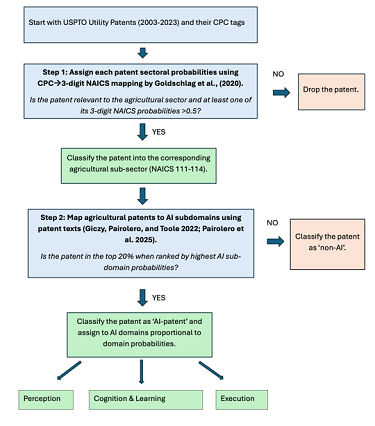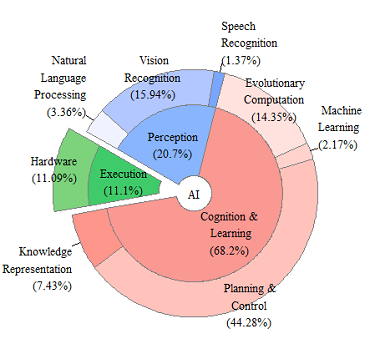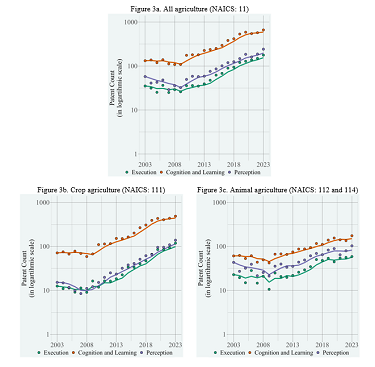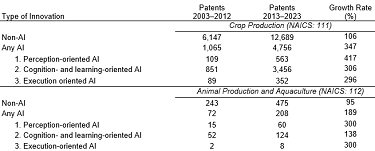
Artificial intelligence (AI) has generated excitement for its potential to transform how food is grown, harvested, and managed (NIFA, 2025). Yet, despite its prominence as a catchphrase, AI remains poorly understood in agricultural policy debates. What exactly constitutes AI in this context? More importantly, does AI represent a turning point for one of the sector’s most persistent challenges in developed economies—the reliance on costly or scarce human labor?
Suboptimal input decisions, unpredictable weather, pest outbreaks, and disease pressures often reduce agricultural yield potential. Even when crops do ripen, a substantial share may go unharvested due to labor shortages or low market prices (Baker et al., 2019; Dunning, Johnson, and Boys, 2019). At the same time, rising climate volatility and shifting trade dynamics have made farming more financially precarious. As labor costs and production risks rise, so do expectations that technology—particularly AI—can offer solutions.
AI promises to address many of these challenges by replicating some human tasks and enhancing data-driven decision-making. Depending on the application, AI may boost productivity, generate new roles in AgTech, or eliminate existing jobs. These questions about the future of work are especially pressing in U.S. agriculture, where dependence on migrant and manual labor remains the norm. To engage with these debates meaningfully, we must move beyond the hype and clarify what AI actually is—not in abstract terms, but in practical, functional ones relevant to agricultural policy.
This article draws on 2 decades of U.S. patent data to examine how AI is being embedded in agricultural technologies. By analyzing the types of AI functions being patented and the sectors they are targeting, we provide a clearer picture of how AI may reshape the nature of agricultural work in the years ahead.

AI encompasses a broad set of computational technologies designed to perform tasks that typically require human intelligence (NIST, 2019). In the broader AI field, AI is commonly classified into three levels of capability: artificial narrow intelligence (ANI), artificial general intelligence (AGI), and artificial superintelligence (ASI) (Wang et al., 2021). ANI systems are designed to perform specific, well-defined tasks—such as identifying pests through image recognition or optimizing irrigation schedules using predictive analytics. This is the form of AI relevant to current technologies and patent activity. In contrast, AGI (artificial general intelligence, or human-equivalent intelligence) and ASI (artificial superintelligence, or beyond-human intelligence) remain theoretical and are not the focus of this analysis. In other words, when most people refer to “AI” in 2025, they are, in practice, referring to ANI. For clarity, this article uses “AI” and “ANI” interchangeably.
To make the concept of AI more useful for policy analysis, we adopt a functional classification based on the human capabilities AI is designed to replicate: perception, cognition & learning, and execution (Wang et al., 2021). This typology aligns well with the structure of labor markets and allows us to assess where AI might substitute or augment human work.
Perception-oriented AI systems replicate human sensory abilities by interpreting information from the physical environment. These systems enable machines to “see,” “hear,” or “sense” environmental cues. In agriculture, examples include
These technologies may partially substitute for manual inspection and monitoring, particularly those involving routine or repetitive observation, while offering improvements in precision, frequency, and scope of observation.

This domain includes AI systems that simulate human reasoning, learning, and decision-making. These tools typically serve as decision aids, helping process complex data to generate predictions or optimize processes. Examples include
These AI tools often enhance managerial and planning functions on farms by enabling more informed decision-making. However, they may also reduce demand for workers engaged in data interpretation or routine logistical tasks.
Execution-oriented AI refers to systems capable of autonomous or semiautonomous physical action. These technologies often take the form of robotics, including
Execution-oriented AI systems raise the most direct concerns about labor displacement, particularly for repetitive tasks. At the same time, their deployment often requires skilled operators and technicians, potentially shifting labor demand toward more technical roles.
This functional classification reinforces that AI is not a single technology but rather a diverse set of tools with varied implications for agricultural work. By classifying AI based on the human functions it replicates, policy-makers can better anticipate which jobs may be automated, which enhanced, and where retraining or workforce development may be most needed. This framework serves as the analytical foundation for the sections that follow, where we explore trends in AI patenting and their potential labor market effects.

To examine the role of artificial intelligence in agricultural innovation, we analyze over 5 million utility patents granted by the U.S. Patent and Trademark Office (USPTO) between 2003 and 2023, obtained from the PatentsView public repository (USPTO, 2025a). The starting year aligns with the broader shift toward digital patent filings and the emergence of AI-relevant technologies in the USPTO corpus. The USPTO is considered a global benchmark for technological innovation, as it accepts applications from both domestic and international inventors and recognizes a broad spectrum of patentable technologies, including AI-driven inventions. Each patent record includes the date of issuance, the assignee’s country of origin, and a structured text corpus comprising the abstract, claims, and technical description. Patents are classified under the Cooperative Patent Classification (CPC) system, which allow researchers to track trends across specific technological areas—for example, walking robots are consistently labeled under B62D57/032.
Figure 1 shows how patents are classified as agricultural patents and, if identified as AI-related, further categorized into functional AI domains—perception, cognition & learning, and execution—based on the technological capabilities likely embedded in the innovation. Figure 1 provides a detailed description of the classification process. As patents do not indicate where technologies are ultimately adopted, we first link patents to the sector most likely to adopt them based on the text description of the patent. Goldschlag et al. (2020) used natural language processing techniques to probabilistically map four-character CPC tags to three-digit North American Industry Classification System (NAICS) codes. For instance, CPC tag C05F—organic fertilizers—maps to NAICS 111 (crop production) with a 64% probability and to NAICS 327 (non-metallic mineral product manufacturing) with a 16% probability, with several other NAICS industries splitting the remaining 20%. The goal is to retain patents most likely used in agricultural subindustries: crop production (111), animal production and aquaculture (112), forestry and logging (113), and fishing, hunting, and trapping (114). If the mapping reveals no relationship with any of the four agricultural subindustries, then we omit those CPC tags from further calculations of subindustrial probabilities. Then, we look at all the remaining CPC tags attached to patents along with their industry-specific probabilities. If a patent has multiple CPC tags referring to the same agricultural subindustry, then we average those probabilities within an agriculture subindustry so that we have one sectoral probability per patent per subindustry. Next, we rank patents along with the maximum of their industrial classification probabilities. We retain the top 20% of ranked patents to make sure we do not consider patents with very low subindustry probabilities relating to agriculture. Once we identify our pool of agricultural patents, we assign each retained patent to an agricultural subindustry if its probability of association with that agricultural subindustry exceeds 0.5. CPC tags mapped by Goldschlag et al. (2020) to NAICS 115 (supporting services in agriculture) were remapped to their corresponding major subindustry (i.e., NAICS 1151 to 111, 1152 to 112, and 1153 to 113).
Next, to distinguish AI-enabled technologies from conventional technological innovations, we apply the crosswalk developed by Giczy, Pairolero, and Toole (2022) and Pairolero et al. (2025), which maps the parsed text of each patent to eight AI subdomains: Machine Learning, Evolutionary Computation, Natural Language Processing, Vision Recognition, Speech Knowledge, Knowledge Processing, Planning and Control, and Hardware. A patent has eight reported probabilities each corresponding to one of the eight AI subdomains above. We rank patents along with the maximum of their AI domain classification probabilities.
We label the top 20% of ranked patents as patents containing AI innovation, or simply “AI patents”; the remaining 80% of patents with much smaller AI probabilities are labeled as “non-AI patents.” Finally, each AI patent is proportionally categorized into one or more of three functional domains—perception, cognition & learning, and execution—based on their relative domain-specific probabilities. These domains reflect the human capabilities AI technologies are designed to
replicate and serve as a foundation for understanding potential effects on agricultural work. The following mapping aligns specific AI subdomains (Giczy, Pairolero, and Toole, 2022; Pairolero et al., 2025) with three broader functional domains identified in the previous section:
Figure 2 illustrates the distribution of AI-driveninnovation across functional domains in agriculture, based on USPTO patents granted between 2003 and 2023. Each AI patent is categorized into one subdomain using probabilistic weights, then grouped into the three overarching domains: perception, cognition & learning, and execution. The inner ring displays the share of each functional domain, while the outer ring provides further detail on subdomains. The results show that cognition & learning accounts for the largest share (68.2%) of AI-related agricultural innovation, with particularly high activity in planning and control (44.28%) and evolutionary computation (14.35%). Perception technologies represent 20.7% of AI innovation in agriculture, with notable contributions from vision recognition (15.94%) and natural language processing (3.36%). Finally, the execution domain—which encompasses AI hardware and robotic control systems—accounts for 11.1% of AI activity. This distribution suggests that most agricultural AI-containing patents are oriented toward enhancing decision-making and predictive capabilities, followed by sensing and automation of physical execution. The presence of execution-related technologies suggests a possible shift toward physical task automation, though this remains a smaller component of AI-driven agricultural innovation relative to the cognitive aspects of AI.

Figure 3 presents the trajectory of AI-related patenting activity in U.S. agriculture from 2003 to 2023, disaggregated by functional AI domain: perception, cognition & learning, and execution. Across the full agricultural sector (NAICS 11), AI innovation shows a clear upward trend, with growth accelerating after 2010. Cognition & learning technologies consistently dominate in patent counts. These technologies—which include machine learning, knowledge representation, and planning systems—likely reflect the growing integration of data analytics, predictive modeling, and decision-support systems in modern agricultural management. Perception-oriented AI innovation, including computer vision and sensing technologies, also exhibit strong growth and converge to cognition patents in recent years. Execution-oriented AI, encompassing automation and robotics, lags in absolute numbers but exhibits the fastest growth in the last decade—suggesting increasing focus on autonomous farm operations.
This pattern is especially pronounced in crop agriculture (NAICS 111), where AI activity has grown across all domains since 2010. Cognition & learning continues to lead, consistent with the data-intensive nature of cropping systems. Perception and execution have also gained traction, supporting applications in plant detection, precision input application, and mechanized harvesting. By contrast, animal agriculture (NAICS 112 and 114) shows a more modest and gradual increase in AI uptake across domains. This slower adoption may reflect the greater biological complexity and variability inherent in animal systems, or it may indicate that existing non-AI technologies remain sufficient for many animal production tasks.
Table 1 compares the growth of AI-related patents in the agricultural sector (NAICS 11) to those in nonagricultural sectors. Between the two decades (2003–2012 and 2013–2023), AI patents in agriculture grew by 237%, outpacing the 97% growth in non-AI agricultural patents. Among functional domains, cognition & learning saw the largest increase (247%), followed by perception (199%) and execution (151%). While nonagricultural sectors had a higher baseline of AI patenting, their overall AI growth (216%) was similar in relative terms. These trends suggest a convergence in AI intensity of innovations between agriculture and other sectors, with agriculture closing the gap in domains such as prediction, decision-support, and environmental sensing.
Table 2 provides a more detailed look at AI trends within agricultural subsectors. In crop production (NAICS 111), AI-related patents increased from 1,065 in the 2003–2012 period to 4,756 in 2013–2023—a 347% increase. The dominant domain remains cognition & learning (with 3,456 patents in the recent decade), while perception grew most rapidly (417%), reflecting expanded use of sensors, imaging, and analytics for crop monitoring and yield prediction. In animal production and aquaculture (NAICS 112), the total number of AI patents remains smaller, rising from 72 to 208 patents (a 189% increase). Yet within this modest base, perception- and execution-oriented AI both grew by 300%, indicating early-stage adoption of technologies like computer vision and automation for animal monitoring, behavior analysis, and facility operations.
Together, these trends highlight the growing functional diversity of AI-driven innovation in agriculture. While most innovation to date has focused on decision-support and predictive systems (cognition & learning), we observe rising interest in complementary technologies for sensing (perception) and, to a lesser extent, automation (execution). Crop agriculture appears to be leading this technological transformation, while animal agriculture has room for future expansion.

The labor market implications of AI adoption in agriculture are theoretically ambiguous and depend on the nature of the tasks affected and the technological capabilities of the AI systems in question. Task-based models of technological change (Acemoglu and Restrepo, 2019; Caunedo, Jaume, and Keller, 2023) suggest that technologies can either displace or complement labor depending on whether they automate specific tasks or raise the productivity of workers engaged in nonautomated functions. If execution-oriented AI technologies—such as robotic harvesters or milking machines—is adopted to perform routine, manual tasks, it may reduce labor demand by substituting for human effort in physically intensive activities. Similarly, if AI for perception-based tasks, including sensors and machine vision systems, is used to automate monitoring and detection tasks, it could displace labor in roles that rely on pattern recognition and routine inspection. However, these technologies may also increase productivity by enabling more timely and granular information, which could raise demand for labor in complementary tasks.
Conversely, if AI for cognition is deployed to support decision-making in complex, uncertain, or data-rich environments, it may augment rather than replace labor. Cognitive AI systems—such as those used for predicting crop needs, optimizing resource allocation, or coordinating on-farm logistics—could increase the marginal productivity of agricultural workers by improving the quality and precision of their decisions. Under this scenario, AI adoption may shift the composition of tasks toward those requiring oversight, interpretation, and responsiveness, potentially creating new roles or expanding the scope of existing ones. Moreover, as emphasized by Caunedo et al. (2023), technologies that enhance productivity may induce within-sector reallocations and local spillovers that contribute to increased labor demand. The net employment effects of AI in agriculture, therefore, are contingent on the specific domains of innovation and their interaction with the task structure of agricultural production.
Artificial intelligence is no longer a distant or abstract concept in agriculture—it is already shaping how decisions are made, how crops and livestock are managed, and how labor is allocated. This article shows that AI-driven innovation in U.S. agriculture is accelerating, particularly in technologies that replicate human cognition and perception. Patent data from the past 2 decades reveal that AI is expanding not only in scale but also in functional diversity, with applications ranging from data-driven decision support to autonomous harvesting.
Yet the implications for the agricultural workforce remain uncertain. Some AI technologies, especially those related to execution and perception, may displace workers in routine or manual roles. Others, particularly in
the cognition & learning domain, may augment human decision-making, boost labor productivity, and create
new roles. The net effect on employment will depend on how these technologies are adopted, how tasks are reorganized, and whether complementary investments in skills and infrastructure are made.
For policy-makers, the key challenge is to anticipate and shape the transition, not merely respond to it. This involves investing in workforce development for increasingly technical roles, supporting access to AI tools for smaller producers, and ensuring productivity gains are broadly shared. It also requires grounding AI policy in realistic assessments of existing technologies, rather than hype. Many agricultural AI tools remain narrow in scope, depend on extensive data infrastructure, or still require human oversight. Policy-makers should invest in independent evaluations of AI performance, support open-access benchmarking of new AI tools, and promote evidence-based support programs that reflect usability and cost-effectiveness on farms. Functional classifications—like the one presented here—can help identify which technologies are most likely to affect farm labor needs and how.
As AI continues to advance, a clearer understanding of its practical applications and labor implications is necessary for crafting policies that promote both innovation and equity in the future of food production. While this article offers a descriptive foundation, drawing causal links between AI adoption and labor market outcomes requires further empirical work. Studies that connect AI use to employment, wages, and productivity will be critical for crafting evidence-based agricultural policy.
For More Information
Acemoglu, D., and P. Restrepo. 2019. “Automation and New Tasks: How Technology Displaces and Reinstates Labor.” Journal of Economic Perspectives 33(2):3–30. https://doi.org/10.1257/jep.33.2.3
Baker, G.A., L.C. Gray, M.J. Harwood, T.J. Osland, and J.B.C. Tooley. 2019. “On-Farm Food Loss in Northern and Central California: Results of Field Survey Measurements.” Resources, Conservation and Recycling 149:541–549. https://doi.org/10.1016/j.resconrec.2019.03.022
Caunedo, J., D. Jaume, and E. Keller. 2023. “Occupational Exposure to Capital-Embodied Technical Change.” American Economic Review 113(6):1642–1685. https://doi.org/10.1257/aer.20211478
Dunning, R.D., L.K. Johnson, and K.A. Boys. 2019. “Putting Dollars to Waste: Estimating the Value of On-Farm Food Loss.” Choices 34(1). https://doi.org/10.22004/ag.econ.283536
Giczy, A.V., N.A. Pairolero, and A.A. Toole. 2022. “Identifying Artificial Intelligence (AI) Invention: A Novel AI Patent Dataset.” Journal of Technology Transfer 47(2):476–505. https://doi.org/10.1007/s10961-021-09900-2
Goldschlag, N., T.J. Lybbert, and N.J. Zolas. 2020. “Tracking the Technological Composition of Industries with Algorithmic Patent Concordances.” Economics of Innovation and New Technology 29(6):582–602. https://doi.org/10.1080/10438599.2019.1648014
National Institute of Food and Agriculture (NIFA). 2025. “Artificial Intelligence.” Available online: https://www.nifa.usda.gov/artificial-intelligence
National Institute of Standards and Technology (NIST). 2019, August 9. “U.S. Leadership in AI: A Plan for Federal Engagement in Developing Technical Standards and Related Tools.” Available online: https://www.nist.gov/system/files/documents/2019/08/10/ai_standards_fedengagement_plan_9aug2019.pdf
Pairolero, N.A., A.V. Giczy, G. Torres, T. Islam Erana, M.A. Finlayson, and A.A. Toole. 2025. “The Artificial Intelligence Patent Dataset (AIPD) 2023 Update.” Journal of Technology Transfer. https://doi.org/10.1007/s10961-025-10189-8
U.S. Patent and Trademark Office (USPTO). 2025a. “Data Download Tables” [data file]. USPTO PatentsView. Available online: https://patentsview.org/download/data-download-tables
———. 2025b. “Classification Resources.” Available online: https://www.uspto.gov/web/patents/classification/cpc/html/cpc.html
Wang, L., Z. Liu, A. Liu, and F. Tao. 2021. “Artificial Intelligence in Product Lifecycle Management.” International Journal of Advanced Manufacturing Technology 114(3–4):771–796. https://doi.org/10.1007/s00170-021-06882-1